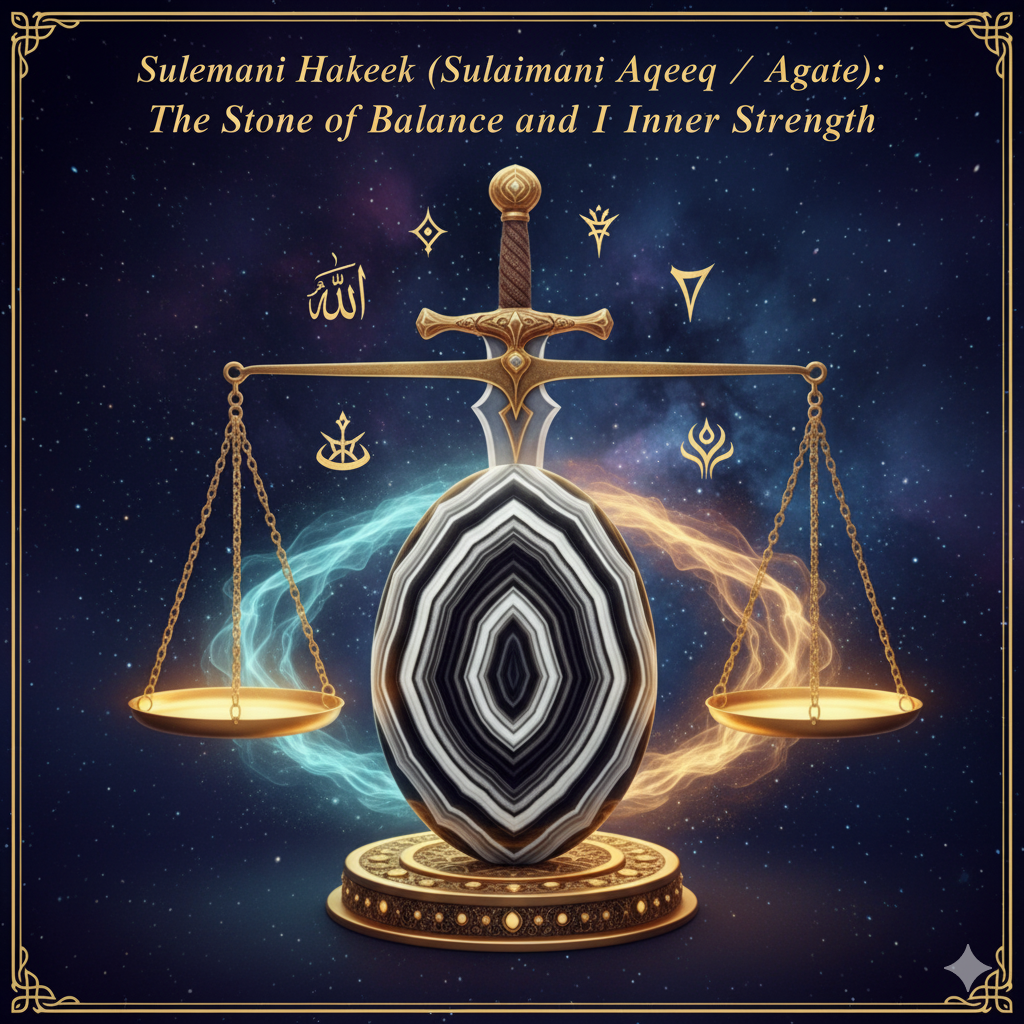Introduction: The Stone That Watches Silently
There are gemstones that sparkle and call for attention — and then there is Sulemani Hakeek.
Deep, banded, calm.
It doesn’t shout. It observes.
Named after Hazrat Sulaiman (King Solomon) — the wise prophet revered for judgment and clarity — Sulemani Hakeek carries the same quiet authority. It is the stone of awareness and restraint, worn for centuries across Arabia, Persia, and the Indian subcontinent by those who wish to think before acting and to feel without being swept away.
To hold it is to hold a pause — a reminder that strength and calm can coexist.
What is Sulemani Hakeek?
Sulemani Hakeek (also called Sulemani Aqeeq or Sulaimani Agate) is a naturally banded variety of chalcedony, a form of microcrystalline quartz.
Its name comes from its earliest trade routes through Yemen and Arabia, where it was believed to have been blessed by Prophet Solomon (Hazrat Sulaiman A.S.), hence the name “Sulemani.”
Common Colours:
-
Black with white or grey bands
-
Brown and cream swirls
-
Occasionally reddish-black or smoky-grey tones
Each band is nature’s fingerprint — no two Sulemani stones are ever identical.
Gemological Profile
| Property | Details |
|---|---|
| Species | Chalcedony (Agate family) |
| Composition | SiO₂ – Silicon Dioxide |
| Crystal System | Trigonal (microcrystalline) |
| Hardness | 6.5 – 7 on Mohs scale |
| Lustre | Waxy to vitreous |
| Transparency | Translucent to opaque |
| Typical Colours | Black, brown, grey, white banded |
These bands are formed by rhythmic deposition of silica from groundwater within volcanic rocks. Over millions of years, each layer creates a unique pattern — some resembling eyes, waves, or ripples.
Historical and Cultural Significance
1. In Islamic Tradition
Sulemani Aqeeq is believed to have been worn by the Prophet Muhammad ﷺ, who encouraged the wearing of agate for its blessings and protection. In Islamic culture, Aqeeq rings are often worn during prayer as a symbol of steadfastness and humility.
2. In Persian and Arabian Heritage
Ancient texts describe Sulemani stones being used as talismans by travellers and scholars. The stone was thought to absorb negative energies, keeping the wearer safe from envy and unseen forces during journeys.
3. In Indian and Tibetan Practices
Hakeek stones are used for meditation and grounding. In Indian gemstone tradition, black Hakeek is believed to absorb scattered emotions, making it ideal for those facing stress, anxiety, or creative restlessness.
Energetic and Spiritual Benefits
Unlike gemstones tied to specific planets, Sulemani Hakeek is universal — its strength lies in neutrality and grounding.
Emotional & Psychological Benefits:
-
Grounding energy: helps stabilize thoughts and reduce emotional volatility
-
Focus and self-discipline: ideal for students, leaders, and creatives
-
Protection from negativity: believed to absorb harmful energies and jealousy
-
Clarity under pressure: encourages thoughtful decision-making
-
Confidence: enhances calm authority rather than loud dominance
Spiritual & Healing Uses:
-
Used in meditation to still the mind
-
Restores equilibrium between body and aura
-
Believed to align the Root Chakra (Muladhara)
-
Placed under the pillow for peaceful sleep and protection from nightmares
Why Sulemani Hakeek is Called the “Stone of Protection”
Its layered composition makes it an energetic shield — each band representing a layer of defense.
Ancient travellers carried it as a charm against evil eyes and emotional disturbances.
Healers and Sufis believed it absorbs and neutralizes negative vibrations.
In the modern world, it remains a symbol of calm leadership — ideal for surgeons, lawyers, CEOs, teachers, and spiritual guides.
Origins and Varieties
| Origin | Description | Colour Profile | Notes |
|---|---|---|---|
| India (Gujarat, Maharashtra) | Traditional cutting centres | Black–white, smoky-grey bands | Most common in South Asia |
| Yemen | Historically prized in Islamic culture | Deep black with silky grey lines | Limited availability |
| Brazil & Uruguay | Modern gemological sources | Brown, grey, white agates | Used for cabochons & ornaments |
| Indonesia | Distinctive patterned Hakeeks | Black–white wave bands | High polish potential |
Though the name “Sulemani” is historical, it refers to the pattern and energy type rather than a strict geographical origin.
How to Identify a Genuine Sulemani Hakeek
Visual Signs of Authenticity:
-
Natural banding visible under light (irregular, not uniform)
-
Cool to touch and slightly heavy for its size
-
Under magnification, translucent edges with cloudy internal zones
Fake Variants:
-
Dyed black onyx marketed as “Sulemani”
-
Glass or resin imitations with perfect symmetry
Always prefer certified stones marked as “Natural Agate (Chalcedony variety)” with no dye treatment.
Price Guide (India 2025)
| Quality | Colour & Pattern | Price / Carat (₹) | Notes |
|---|---|---|---|
| High Grade Sulemani | Natural black-grey bands, uniform polish | 400 – 1,200 | Ideal for rings & talismans |
| Medium Grade | Less visible banding, matte finish | 150 – 400 | Common prayer stones |
| Commercial / Dyed | Artificially coloured | <150 | Decorative only, not energy stones |
Sulemani Hakeek is valued not for brilliance but for purity of pattern — the natural symmetry of its light and dark layers.
Wearing and Ritual Use
Unlike planetary gems, Sulemani Hakeek has no fixed day or mantra. It can be worn anytime with sincerity and clarity of purpose.
Recommended Use:
-
In a silver or steel ring or pendant, touching the skin
-
Can be carried in pocket or prayer beads (tasbeeh)
-
Cleanse occasionally with mild soap and running water
-
Set personal intentions or prayers before wearing it
Emotional Symbolism
Where rubies shout passion and sapphires demand respect, Sulemani Hakeek simply listens.
It belongs to those who wish to lead without noise — who find strength in stillness.
For people facing emotional storms, it acts like an anchor.
For those in high-pressure environments, it slows the breath.
Its black and white bands remind us that balance is not about perfection — it’s about harmony between light and dark.
Jewellery and Modern Use
Today, Sulemani Hakeek is worn both for fashion and meaning.
-
Men’s Rings: Polished oval cabochons in silver or steel
-
Women’s Jewellery: Paired with moonstone or pearl for yin–yang harmony
-
Prayer Accessories: Tasbeeh beads or pendants for meditation
-
Corporate Wear: Matte-finished cufflinks or bracelets symbolizing focus
At PreciousCarats, each Sulemani Hakeek is curated not for gloss but for integrity — natural pattern, certified authenticity, and quiet presence.
Care & Maintenance
-
Clean gently with a damp cotton cloth
-
Avoid harsh acids, ultrasonic cleaners, or perfumes
-
Recharge occasionally by placing it under moonlight or near Himalayan salt
-
Cleanse periodically, especially after emotional events or prolonged wear
FAQs
Q1. What is Sulemani Hakeek used for?
It is used for emotional grounding, protection, focus, and mindfulness — suitable for anyone seeking inner balance.
Q2. Is it the same as Black Onyx?
No. Onyx has straight parallel layers; Sulemani Hakeek’s bands are curved, irregular, and organic.
Q3. Can anyone wear it?
Yes — it has no planetary restrictions or negative side effects.
Q4. How to know if my Hakeek is real?
Look for natural uneven patterns and certification mentioning “Natural Agate (Chalcedony).”
Q5. Does it bring luck?
It is considered more protective than lucky — its strength lies in stabilizing energy, not attracting fortune.
Conclusion — Stillness in Motion
Sulemani Hakeek is not a loud gem. It doesn’t sparkle or shout. It steadies.
It teaches the art of pausing between thought and reaction — of holding silence in a noisy world.
Its beauty lies in its restraint: black and white entwined, wisdom and instinct in balance.
Whether worn as a ring, kept close in prayer, or simply held in the palm, Sulemani Hakeek whispers one truth —
“Peace is not found in escape; it is born of understanding.”
For those walking through uncertain times, it becomes less a stone — and more a quiet companion.

